公開日 2021年11月12日
Kofun (Tumulus)Period
The Construction of Kofun
Constructing large-scale burial mounds (kofun) was started around the late 3rd century in the present Osaka-Nara area.Big burial mounds which are square at the front, round in the rear, or keyhole-shaped, were made along the Seto inland sea, in Kyushu, and in the southern Kanto region simultaneously.Kofun was not only the tomb of the leader of a powerful clan but also a political monument to show off his great power and propagate the idea that the power should be hereditary.The following 450 years is the period when numerous burial mounds were constructed in various parts of Japan.
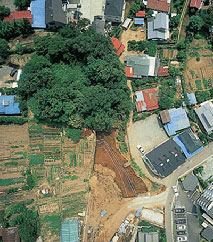
Kofun are classified into various types. In Isehara, square, keyhole-shaped, and round ones were found.Square ones can be found throughout this period, though there are not so many.In Isehara, Tsukagoshi Kofun in Takamori, made in the mid-4th century is one of them. Daijinzuka Kofun to the east of Mitake Shrine, Ikebata, is most probably another square tumulus of the same age.
Many of the keyhole-shaped burial mounds were made in the early Kofun period.Scattered from the southern Kyushu to the southern Tohoku region by the late 4th century, they are considered the symbols of the influence of the Yamato court. Ishida-Kurumazuka Kofun, or also called Aiko-Otsuka Kofun, on the border between Isehara and Atsugi, to the south of Aiko-Ishida Station, was once considered round, but it was found keyhole-shaped after an investigation.Presumably, it was the tomb of the leader of the powerful clan who ruled this area from the early to the mid-Kofun period.
The photo on the upper right shows Ishida-Kurumazuka Kofun, which is also called Aiko-Otsuka Kofun. The square part and the moat of the tumulus are seen brown in this photo.
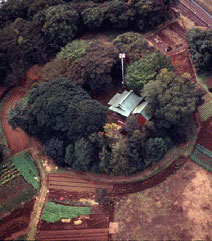
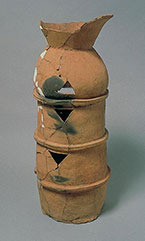
- Koganezuka Kofun in Takamori is a round-shaped tumulus, 46m in diameter.
It produced the oldest clay figure in the southern Kanto region.
This trumpet-shaped figure is 79.4cm in height.
Koganezuka Kofun in Takamori is also famous as a round tumulus of the early Kofun period.It has a beautiful round mound, 46m in diameter and 6m in height.It produced a trumpet-shaped clay figure which is said to be the oldest in the southern Kanto region.Like Ishida-Kurumazuka Kofun, it stands on a place commanding a good view of the surrounding lowland area.Most of the round tumuli of the city were made in the late Kofun period.Hundreds of them once existed centering around Sannomiya and Takabeya in the past.
The Center of Kofun Culture
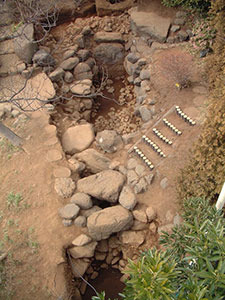
The photo above shows the horizontal stone chamber in Rachimen Kofun. It was built with large stones.
In the 6th century. the number of the large-scale burial mounds decreased nationwide, while small-scale round or square mounds were built.And also there are places where hundreds of those mounds are clustered together.The round tumulus is about 20 meters in diameter and in the mound is a chamber made by piling riverbed stones.The side of the mound has an entrance to the chamber where the body was rested.A number of round burial mounds of the late Kofun period still existing in Isehara are concentrated in Sannomiya and Takabeya.Over there a big rock which was used for a stone chamber can be seen lying in the corner of a tangerine orchard on a hill.
Among all, Tonoyama and Rachimen Kofun in Sannomiya are very special.Tonoyama Kofun, located between Sannomiya and Tsubonouchi, produced gilt-bronze horseback riding equipment, a gilt-bronze ornamental sword, a bronze bowl, and a bronze mirror.Fragments of house-shaped and human-shaped terracotta tomb figurines were excavated from nearby farmland.From the big stone chamber of Rachimen Kofun, 800 meters to the north of Tonoyama, gilt-bronze horseback riding equipment and an ornamental sword with the hilt bound with silver threads were excavated.With a diameter of 40 meters, this is especially large as a burial mound of the late Kofun period.These meticulous handicrafts were made using advanced techniques introduced from the continent.It seems that the groups of craftsmen with special skills were administered by the central government.The fabulous tomb furnishings of Tonoyama and Rachimen Kofun make it clear that this land was under the influence of the central government in the Yamato Basin (present Nara).
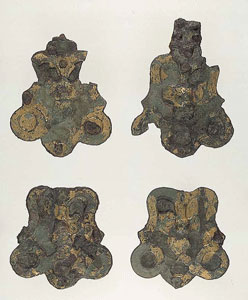
Horseback riding equipment found in Rachimen Kofun
They were used to decorate a horse, made of two layers of iron and gilt-bronze sheets. The one on the upper right is 14.4cm.
A set of an ornamental sword, horseback riding equipment, and a bronze bowl seems to be the status symbols to acknowledge the man’s supremacy because the similar items were discovered in other big burial mounds nationwide. Gorgeous tomb furnishings of Tonoyama and Rachimen can tell that the supreme leaders of this area were buried there.
From a different site in Sannomiya, two decorative gilt-bronze rings which were to be mounted on the hilts of ornamental swords were excavated. Some people say that Sannomiya was the place where the successive chiefs of the Sagami province were buried. And in Hinata, a straight sword with a gilt-bronze decoration (from Shibuta Ichi-go Tumulus) and a sword which has a handguard inlaid with silver (from Arozu Tumulus) were unearthed. No other areas in Kanagawa Prefecture have produced such a great number of swords, horseback riding equipment, and accessories. It is obvious that Isehara, in those days, was the most sacred and important place for the ruler of the Sagami province.

Gold is plated on the handguard and the hilt-head of the straight sword found in Tonoyama Kofun. The blade is 72.3cm long.
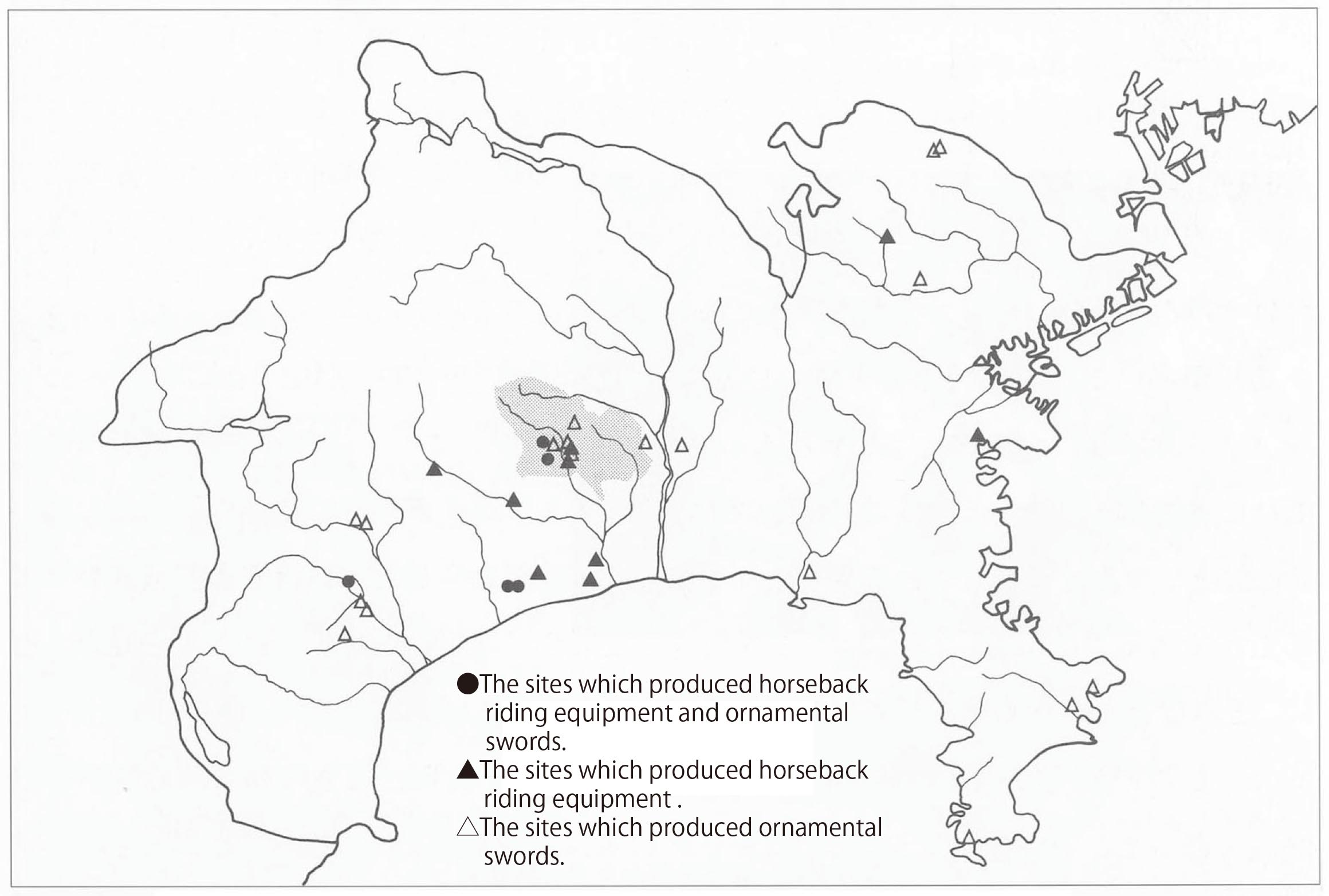
A distribution map of the items which were buried together with the deceased.
The distribution map shows the sites which produced ornamental swords and gilt-bronze horseback riding equipment which were the status symbols in the Kofun period. In Kanagawa Prefecture they concentrate in Isehara.
The Spread of Buddhist Culture
It was in 538 that Buddhism was introduced to Japan from Paekche, Korea. At that time the Yamato government obtained the most advanced things and ideas of China and Korea by way of Paekche and Buddhism was one of those which came from overseas. First, the Soga clan built Asuka-dera Temple. When Prince Shotoku officially recognized Buddhism in the Constitution of 17 Articles, Buddhism was held in high esteem not only as a belief but also as political means to govern the nation.
The Soga clan was destroyed by Prince Nakano-oe and his followers in 645 and the political reform called Taika-no-Kaishin was carried out, in which Buddhism was well protected. In the following year, a new law called Taika-no-Hakusorei was proclaimed prohibiting the construction of huge burial mounds. Behind this, there was an influence of the Buddhist view of life and death as well as a change in the way how people worshipped the ancestral spirits. Before long, Buddhism was introduced to the Kanto region.
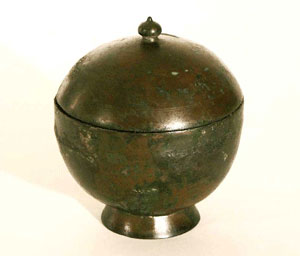
The photo above shows the bronze bowl, 13.2cm in height, found in Tonoyama Kofun. It was originally used in Buddhist rituals. It is one of the four bronze bowls unearthed in Kanagawa Prefecture.
It is said that Hinata-san Ryozen-ji Temple was established by the priest Gyoki in 716, and Oyama-dera Temple, by the high-ranked priest Roben in 755. Both of them are very old temples, but even before then, this area had been under the influence of Buddhism. The bronze bowl unearthed at Tonoyama Kofun should have been used in Buddhist rituals, which means Buddhist culture was introduced here by the end of the 6th century at the latest.
The spread of Buddhism affected the way of people’s ancestor worship as well as local leaders’ attitude to the construction of huge burial mounds. Until then, they showed off their power by constructing huge tumuli. In this way the Kofun period came to an end.
Next⇒Nara Period
- Geogaraphical Features of Isehara
- Paleolithic Period
- Jomon Period
- Yayoi Period
- Kofun (Tumulus)Period
- Nara Period
- Heian Period
- Kamakura Period
- Muromachi Period
- Civil War Period
- Edo Period
- Meiji, Taisho, and Showa Periods
Previous⇒Yayoi Period


